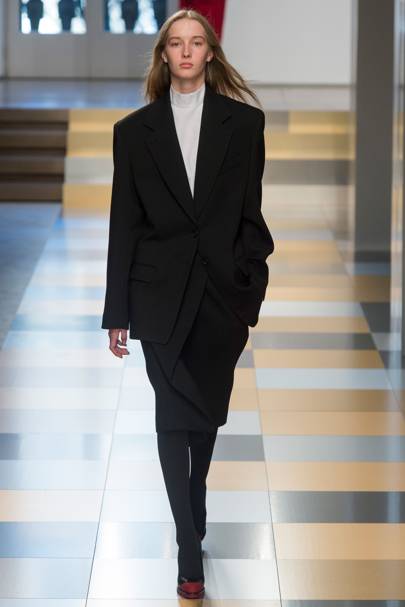When Raf Simons was at the helm of Jil Sander and his eponymous label, just months before taking the reins at Dior, the Belgian designer drew this telling illustration: “Fashion is such an octopus. You’re connected to so many people: suppliers, pattern makers, production teams, marketing teams, vendors.”
As it currently stands, the global apparel industry is valued at an astounding $3 trillion USD. For perspective, that’s an octopus worth more than the UK’s GDP and about 2% of the world’s total GDP.
These numbers, though merely quantitative, help illuminate the notion that fashion is both an art and a formidable science. But behind the hard data and complex mechanics lies a slightly less acknowledged variable of human cooperation. And as with most human relationships, those involved in the fashion industry require a good amount of courting and matchmaking.
Many established fashion brand names have come out on top by virtue of their own artistic vision and entrepreneurship. But in today’s increasingly open and fast-paced digital age, a superabundance of supply and a saturated market has not only made it more difficult for emerging brands to stand out, but has also encumbered consumers with a burden of overchoice and an increased appetite for curated, narrowed-down selections.
For both cases, a retailer fills this void. On the consumer side, many individuals appreciate the convenience of a one-stop shop; others value the stamp of approval; and some treat it as a channel of discovery. For emerging brands, getting a reputable retailer to stock your product is essentially earning membership to a club, whereupon you have access to a host of benefits such as exposure, collaboration and endorsement.
Yet the task of finessing one’s way into the retailer big league entails a complex process that involves foresight, tenacity and a little bit of romancing. With remarkably high rejection rates.“For every 300 brands that are pitched, we may select one or two,” says Boston-based boutique Bodega, the endeavor can seem daunting at the least and impossible at the most.
To shed light on the often impenetrable process of how stockists choose the brands they carry, we sat down with the people behind leading menswear retailers Bodega, Goodhood and Concepts, to pick their brains on how to secure a successful retailer-brand partnership.
Here are five tips that will help fledgling brands succeed in the fashion world’s ultimate courting game.
1. Look Beyond What’s Trending Now
Different retailers look for different styles and trends, but if your brand is only stuck on what’s trending now, it won’t last. Sneaker boutique Concepts found its beginning in Cambridge, Massachusetts in 1996, years ahead of today’s streetwear-meets-high-fashion boom. “We were one of the first stores to position brands like Balenciaga next to Nike SB, and have kept our buys under that voice since,” Creative Director Deon Point tells us. Today, Concepts International has expanded their eye for streetwear to a global scale, setting up shops in NYC and Dubai.
When buying, the first thing they consider is longevity. “Part of the buying process is evaluating what brands have staying power. Often times they rely on trends without considering the bottom will eventually fall out.” To demonstrate a foresight for long-term shelf life, Point advises to “analyze the market thoroughly before jumping in. You can’t add to what exists by recreating what’s already there.”
For cult-favorite streetwear boutique Bodega, having industry foresight is all about knowing what’s up and coming. “As a buyer, you want to predict the future, be inside your customer’s collective consciousness, anticipate changes in the market, and do endless hours of analysis of how the brands you’re already carrying are performing.” While copious amounts of homework and collecting data are surefire tactics, the people at Bodega also admit that intuition and prophesying, if you have the knack for it, will do the trick. “Nostradamus or Miss Cleo would’ve made great buyers since you need a vision 6-12 months out of what will be relevant,” the team adds, half-jokingly.
London menswear and lifestyle retailer Goodhood has established itself as a cultural authority with its well-curated and vast range of products. Founder Kyle Stewart’s advice is at once straightforward (“above all make good product”) and exacting (“do your homework and offer something different while being aware of the market”), which brings us to our second point.
2. Stay True to Your Brand Identity
Understanding your brand’s identity will help locate it within the larger market. According to Stewart, Goodhood’s main mission is a matter of enriching its brand’s style. “We look at what will work for us and our customers,” says Stewart, who describes Goodhood’s style as a mix of casual, indie and modern classics. “Aesthetically it needs to fit into our look and feel, we don’t particularly care for what’s trending. In fact, if something is just too hype and gets distributed through channels we don’t align with, we will disregard the label.”
Similarly, Concepts also seeks an aesthetic match in the brands they stock. “We try to stay true to the aesthetic and brand voice at all times,” Deon Point adds. “More often than not, brands themselves will reach out, so it’s just a matter of evaluating if they fit into our vision.”
But finding a compatibility in brand identity doesn’t necessarily mean similar style. Retailers such as Bodega thrive on an interest-based buying philosophy. “We explore the intersection of contemporary fashion, counterculture, design, art and sport. If you were to look at those fields as a Venn diagram, our aim is the overlap of two or more of those circles at a time.” Under this framework, aesthetically different brands such as Hender Scheme and Human Made both fit in at Bodega.
3. The Fashion Business is Built on Human Relationships
Behind every business are individuals who respond to human sentiments. Basic principles of respect and trust will foster loyal partnerships that will carry you far in the industry. In Kyle Stewart’s words, it’s a simple philosophy: “We will try and support our friends and like to help good people.”
But the results are manifold. For retailers like Bodega, once a new line is taken in, it’s an alliance that will last through thick and thin. “If a brand has a bad season, we can ride it out together.” Reassuringly, Goodhood’s team echoes the same opinion: “We will normally stick it out with them and try and help them get back on track.”
On top of creating a safety net, strong networking can also open up channels. “This industry has a lot of crossover, so a buyer may transition to brand side or an individual may end up high on the totem pole at another brand,” comments Bodega, ”If you maintain professional standards across all relationships, you’ll prosper.”
“A sneaky way to the buyer is through the sales staff… convince the sales staff that a brand is a must have, that signal will get to the buyer.”
While good etiquette has long-term benefits, tactful networking can also find shortcuts for instant results. “A sneaky way to the buyer is through the sales staff,” reveals the Bodega team. “If you can convince the sales staff that a brand is a must have, that signal will get to the buyer. You’ll be sending PR, line sheets, PDFs via email and trying to get an appointment to pitch the brand to the buyer. If they have heard of the brand through a word of mouth recommendation, they’re 10 times more likely to give you some valuable time.”
Ultimately, in-person cooperation cannot be avoided in the process establishing a retailer-brand partnership. “If you don’t have a relationship established, you’ll need an introduction and a face to face meeting,” Bodega asserts. “It’s important for us to be able to shake hands and work with people we like,” concurs Goodhood. “Oh, and if you don’t have the social skills to sell your product (and there’s nothing wrong with being honest about this), get someone that can.”
4. Understand How a Brand Will Perform Online Versus in Brick & Mortar Stores
Concept’s Deon Point emphasizes that different brands require different attention. “From E-commerce, we can get instant feedback on brands we carry and introduce them to our entire audience; the brick and mortar is a more hyper-local experience. That being said, some brands like A Bathing Ape can only be sold in-store, which provides more customer engagement and makes the store a destination. You can also see things in hand and try them on in-person. We aren’t taking returns on $1,000 USD visvim denim jackets, so it’s beneficial to have a physical location for people to try them on and make sure it’s perfect.”
For Bodega, IRL stores are much more than about selling a product. “Brick and mortar retail has an enormous possibility to connect with an audience in more dimensions than a photograph or screen. The greatest thing we accomplished early on is the fact that everyone who comes in our store feels something. Vibes they say.”
On the other hand, Stewart points out the obstacles that B&M shops face. ”Ironically, having a store can sometimes count against us being able to stock a brand [because] the geographical location of our store can mean brands will not sell to us because of proximity to other stores.” According to Stewart, the future of retail is a fusion of both platforms. “Technology is crossing over into the physical retail space and I find this an interesting development especially for the long term. I don’t think it’s as simple as a solely digital solution but the crossover of digital and physical is particularly interesting.” Eventually, we hope to see the efficiency and accessibility of e-commerce and the accuracy and experience of B&M will come together for the future of retail.
5. Trade Shows Are Still Important
While sharing an image of your product is a quick and dirty way to get the word out, nothing compares to the spectacle of trade shows. Events such as ComplexCon, Pitti Uomo, and Capsule are huge networking platforms that give growing brands a chance to communicate their vision and products in a holistic and fully-immersive way. More importantly (and pragmatically), these events are where most deals and partnerships are made between retailer and brand.
When your brand is ready to present, the first step, according to Bodega, is to get on the sales calendar. “Buyers operate on seasonal budgets and are trying to fill their stores with product at certain times during the year. Get your production in lockstep with the trade show seasons and plan your order deadlines accordingly. These two statements may seem obvious, but most new brands that approach us do not know this.”
The second step is to make the most out of trade shows. Bodega’s team advises to prepare a business plan and ask questions such as: “What brands would your line make sense to merchandise next to? Who sells those brands? Does this type of product already exist in the market?” Along the same lines, Goodhood’s team recommends to “be aware of the pricing structure of products and the margins retailers would look for.”
For brands that don’t have trade shows at their disposal, there is still a wealth of channels through which your brand can gain traction. “We get recommendations from staff, clients, stylists and other buyers,” says Bodega. “We read the trade publications (including Hyper Beast). We travel and see what energy is in the street globally. We follow our muses through social media, and take influences from the worlds of art, design, sport and music.”
In the end, if you’ve milked all of these tips to no avail, Deon Point says: “Get someone famous to wear it and make the most of your 15 minutes.”




















































